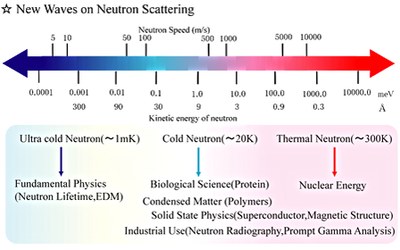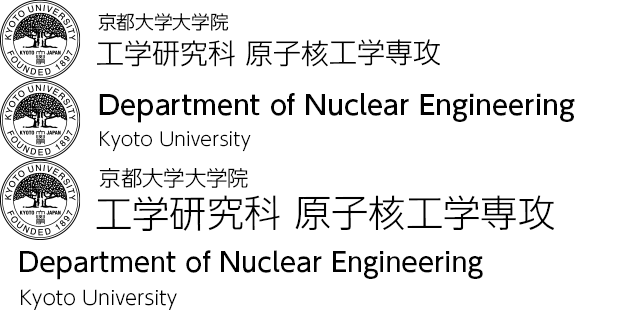Neutron Physics and Engineering
Slow Neutrons are being widely used as a microscopic probe in the field from elementary physics to biological-science. In the condensed matter physics, neutron is a powerful tool to investigate microscopic structure and dynamics due to its unique property that it has no charge and behaves like quantum particle and wave.
In our laboratory, intense neutron sources and precise neutron measuring device based on neutron optical properties are studied. Our aim in research is to apply neutrons to new fields in both scientific and industrial use.
Academic Staff
Tatsuya HINOKI
Professor (Graduate School of Engineering)
Research Theme
Seiji TASAKI
Associate Professor (Graduate School of Engineering)
Research Theme
Through experimental research, we study efficient usage of thermal and cold neutrons, mainly using compact neutron sources, JRR-3, J-PARC, KUANS (Kyoto University Accelerator driven Neutron Source).
Especially utilizing the wave properties of neutron we study on
- development of neutron propagating devices such as neutron mirrors, neutron guides etc.
- development of the method of neutron as probe for investigating materials.
Classes
Neutron science and engineering (H19-), Reactor Physics, Neutron science
Contact Information
TEL: +81-75-383-3912
FAX: +81-75-383-3912
E-mail: tasaki@* (Add "nucleng.kyoto-u.ac.jp" after @)
Yutaka ABE
Assistant Professor (Graduate School of Engineering)
Research Theme
We are working on basic research for high-intensity cold neutron sources, and also on material research by using the scattering and transmission phenomenon of neutrons.
- Analysis of neutron scattering cross-sections for cold moderators by molecular dynamics simulation
- Generation of thermal neutron scattering libraries for various cold moderators
- Numerical studies on neutronic properties of pulsed and steady-state sources
- Generation and storage of ultra-cold neutrons by superfluid helium
Contact Information
Katsura Campus, C3 building, Room d2S08
Kyotodaigaku-Katsura, Nishikyo-ku, Kyoto 615-8540, Japan
TEL: +81-75-383-3913
FAX: +81-75-383-3913
E-mail: yutaka_abe@* (Add "nucleng.kyoto-u.ac.jp" after @)
Research Topics
Application of neutrons to science and industry
Since neutron has no charge and hence it can 'see' the nucleus in an atom, we can determine position of nuclei from neutron data. In addition, owing to large scattering length of light elements, intrinsic magnetization and high transmittance, neutrons are, like x-rays and synchrotron radiation, applied to the many fields related to industrial and scientific use. Neutrons are utilized for many different purposes on account of its kinetic energy. Among them, low energy neutrons with 100 meV or less are most widely used in scientific and industrial fields, which are classified as 'thermal neutron', '(very) cold neutron', and 'ultra-cold neutron'. Thermal neutrons have been used in fundamental field of interferometry and diffractmetry and also in applied field of activation analysis and radiography. Cold neutrons are a promising tool to investigate microscopic structure and dynamics of condensed matter consisting of huge molecules, such as biological materials and polymers. Ultra-cold neutrons are very slow less than 5m/s. They are now being used to investigate fundamental properties of neutron itself as an elementary particle and hence to develop fundamental physics through the so-called measurement theory.
In our laboratory, generation and application of those low energy neutrons are studied by both theoretical and experimental approaches.

Figure 1:Low energy neutrons and their applications.
Molecular dynamics studies of super-fluid helium, liquid hydrogen and solid methane
Our aim in research is new application of neutrons toward clean energy technology and material science. We are now developing neutron scattering models on molecular dynamics for super-fluid helium under Bose condensation, liquid hydrogen and deuterium with nuclear spin correlations and molecular rotations, and liquid and solid methane with quantized rotational motions. The cross section results will be open to the scientific use through the computer network.

Figure 2:A molecular dynamics model on liquid water with hydrogen bonding network and its analysis by cold neutron scattering
Developments of neutron spin echo spectrometer based on neutron spin interferometry
Slow neutrons show wave properties very clearly. Their spin selection and spin inversion is quite easy. These properties enable us to realize neutron interference between spin states of neutron with lower spatial precision comparing to the conventional neutron interferometry.This type of neutron interferometry is named as neutron spin inteferometry. The main application of neutron spin interferometry to the material science is the neutron spin echo technique. When the neutron spin interference pattern is analyzed, very small change of neutron speed due to the scattering by condensed matter, can be detected. This type of spectrometer, which is called neutron spin echo spectrometer, is realized and developed at the reactor neutron sources since 1970's, whereas at the spallation neutron sources with pulsed neutron beam such spectrometer has not yet achieved and we are now developing. A preliminary result is shown in the figure. This result is the world first measurement of neutron spin echo signal at the pulsed neutron source (KENS in Japan).

Figure 3:The first neutron spin echo signal measured at the pulsed neutron source (Maruyama et al.)
Research and development of spallation neutron sources for biological and material-sciences
Since low energy neutrons show an intrinsic property of de-Broglie wave, it is useful for study of condensed matter physics in terms of microscopic dynamics and structure analysis. In US and Japan, intense spallation neutron sources are now under construction and low energy neutrons are now being used as a unique probe for the polymer and biological-science.
In our laboratory, generation and utilization of ultra-cold and cold neutron are also studied from a theoretical viewpoint.
